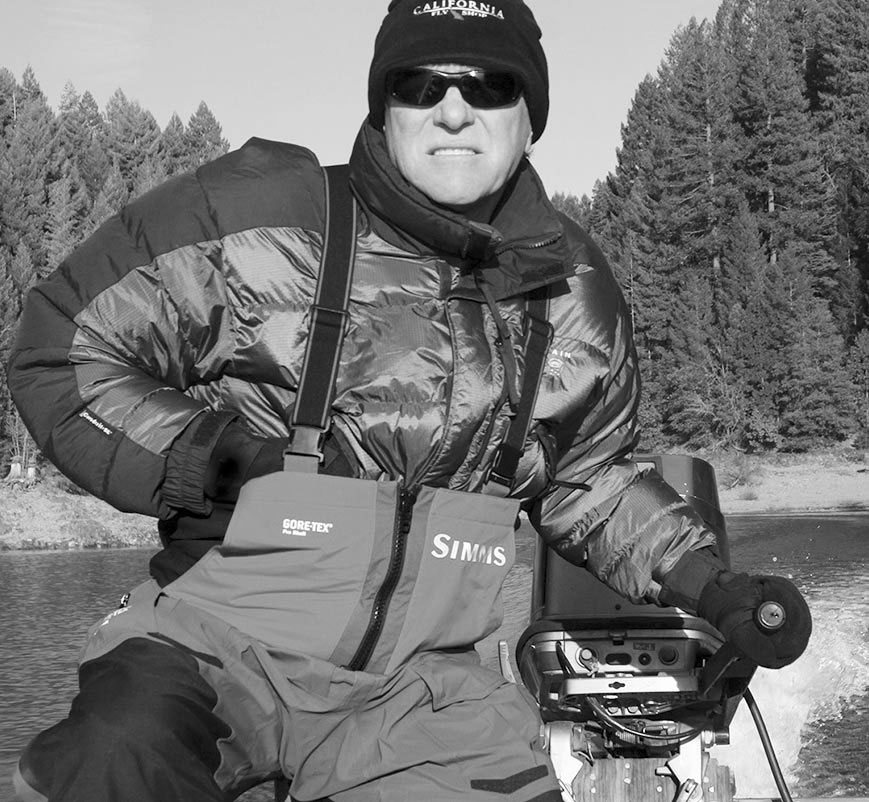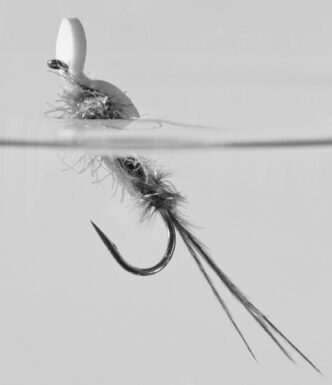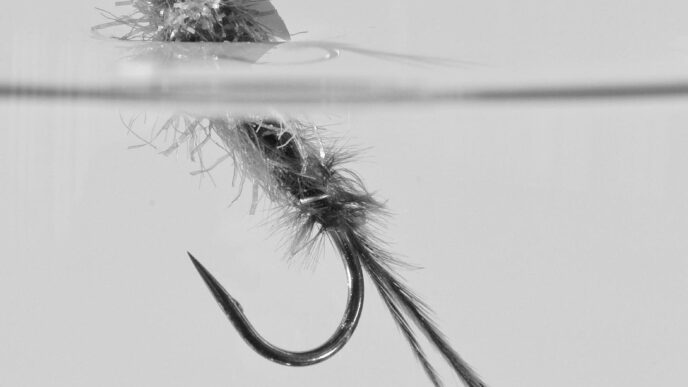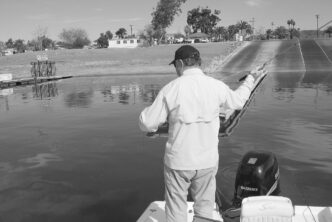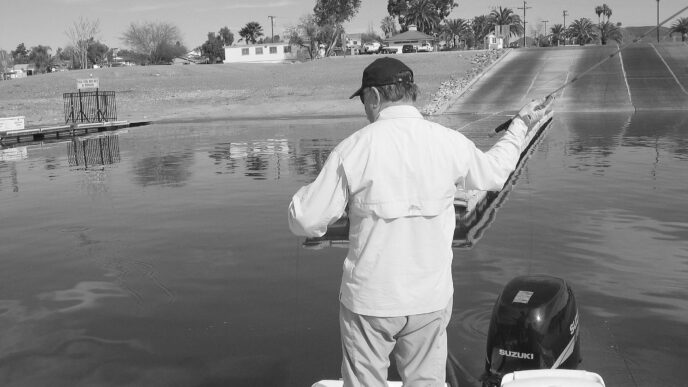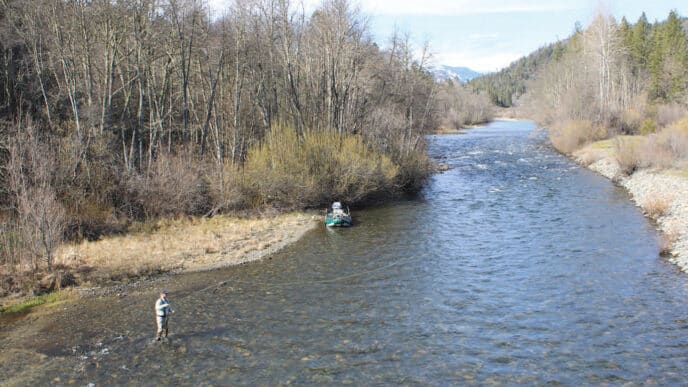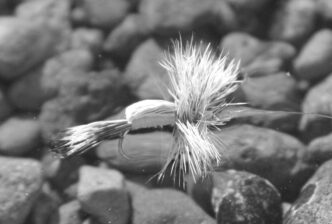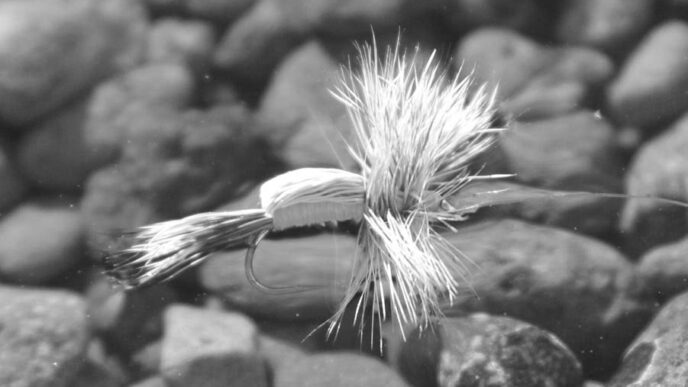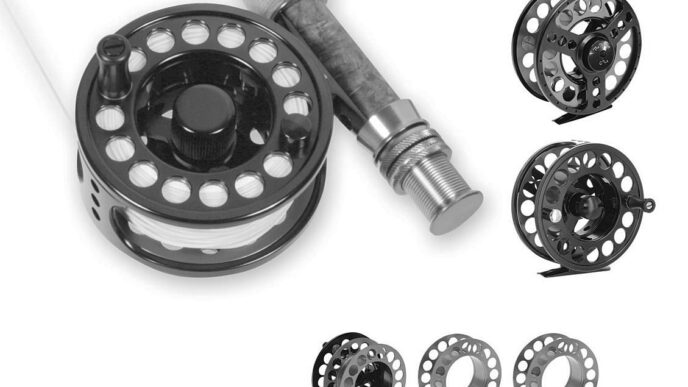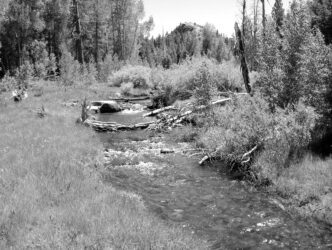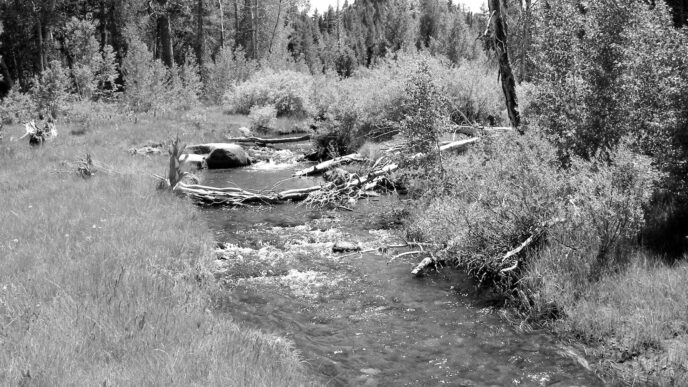Our puny, hairless bodies, with blood vessels only skin deep, were designed for digging tubers under the blazing African sun or chasing wildebeests over cliffs. We were not built to wallow through slush, then break through ice so that we could wade in barely melted snow and fish for trout. Winter fly fishing is clearly an act of evolutionary defiance.
Suffice it to say, we couldn’t be fly fishing in winter without Stuff. Stuff is supposed to keep us dry, warm, and comfortable when we’re doing what nature didn’t intend us to do. Fishing in snow would seemingly be the epitome of hardcore winter angling, but in reality, I’ve been much colder plying the deep, damp, sunless canyons of the foothills and coast ranges and while running a boat through frigid Delta fog.
Waders: Keeping Warm and Dry
An extremely important concept to keep in mind while choosing Stuff to buy is that your body doesn’t perceive temperature as much as it perceives the rate of heat transfer from itself. Dry, cold air isn’t nearly as efficient at transferring heat from your body as is humid air of the same temperature. In terms of keeping us warm and dry, the greatest invention in the history of fly fishing is the waterproof, breathable fabric created by Bob Gore.
By accident, Gore invented the GoreTex membrane by simultaneously heating and stretching sheets of PTFE — essentially Teflon. The treated sheets contained some 9 billion pores per square inch, with each pore being about 1/20,000 the size of a water droplet. In theory, water vapor would pass through the pores, but liquid water couldn’t. Early versions of the product were easily contaminated by sweat, grease, or bug dope and leaked profusely in actual field conditions. I was guiding in Alaska during this period and wasn’t even a little bit happy about being stuck in the middle of nowhere, beta testing someone’s failed science fair project. I went so far as to write angrily in a book, in all caps, “Gore-Tex is a hoax!” Fortunately, we’ve come a long way in 30 years. Gore-Tex has gone from hoax to magic.
The magic of Gore-Tex and the other waterproof, breathable fabrics that it spawned is that it decreases the humidity between the body and the fabric. The humid vapor that is exhausted through your skin passes through the Gore-Tex and leaves you warm and dry. Old-school rubberized and neoprene waders would keep you dry, but the trapped humidity inside was onerous in the summer and bone numbing in the winter. Instead of relying on a few millimeters of neoprene to keep you warm, you can now be insulated with true cold-weather Stuff.
You can wear cotton sweats or Levis under your waders, but do it knowing that you are wasting the better part of breathable wader technology.
Cotton soaks up sweat and doesn’t like to release it. True modern underwader garb, by contrast, is pretty amazing. The fibers closest to the skin are hydrophilic (they love water), and the outer fibers are hydrophobic (they hate water). The hydrophilic fibers suck the sweat from your skin and wick it to the outer fibers, which smear it out into a microscopically thin coat that enhances evaporation through the Gore-Tex. When the going is really cold, I wear thin PolarTec tights under an appropriate-weight fleece. The combination is dryer (thus warmer) than a single bulky insulation layer that doesn’t fit sheer to the skin.
Breathable waders are coated with a durable water repellent (DWR) coating to keep water from soaking into the “face coat” fabric that protects the permeable membrane underneath. Over time, the DWR wears out, and the face coat becomes wettable. You’ll still remain dry, but will experience a noticeable chill from evaporative cooling as the water evaporates from the waders. Follow the manufacturer’s instructions for recharging or reapplying the DWR, because not all breathable waterproof fabrics are the same.
Your Feet
The Achilles heel of breathable waders is that they come with nonbreathable feet. Each foot exhausts as much as a pint of water through the course of a day. That sweat has nowhere to go inside the neoprene socks, and your feet end up stewing in their own broth. To exacerbate the problem, any leaks in the waders above the feet are likely to drip into the sock, although it is amazing how much water will pump out through the Gore-Tex, rather than remain in the waders.
Feet are the most vulnerable part of the body when it comes to getting cold. They are the farthest things from the heart, and there is precious little insulating fat. An angler’s feet are immersed in cold water and all too often compressed by ill-fitting boots or too many socks. Rule number one when trying to avoid cold feet is to get a well-fitted wading shoe. Fit your prospective wading shoes while wearing the waders and socks you will be wearing when fishing. Don’t depend on some online sizing chart or rely on the size of your street shoes. A size 12 Patagonia is not a size 12 Korker, much less a size 12 Nike running shoe. Buy shoes at the end of the day, when your feet are swollen, and be certain that your toes have wriggle room.
You owe it to yourself to try some socks that are specifically designed for wading. You’ll be amazed at how nice they are. Hiking and running socks are padded primarily on the soles for shock absorption. Wading socks provide extra insulation around the toes, the top of the foot, and the ankle. Ski and snowboard socks are warm, but rarely have enough elasticity to keep from getting scrubbed down the leg by the constant chafing of waders.
All good wading socks are designed to wick moisture away from the skin and toward the outside of the sock. Unfortunately, there isn’t a sock in the world that can effectively absorb all your sweat, contain it inside a waterproof neoprene shell, and keep your feet from feeling damp and chilled by the end of the day. A thin silk or polypropylene liner sock does help, but the best strategy for warm, dry feet is to carry an extra pair of socks and change your socks at lunch. Your feet will love you for it. Though technically challenging to produce, I’d like to see neoprene wader feet that incorporate a Gore-Tex panel or “chimney” to help move sweat back up to the breathable part of the waders. It’s just an idea, but one that I think has merit.
Jacket Design
Most fishing jackets are made of Gore-Tex or similar fabric, but only a few have underarm zippers. Some anglers like to stand on a one rock all day, but I prefer to move. If it’s stormy and I plan on doing much walking, the fishing coat stays home, and instead, I wear my mountain parka, which has pit zips for ventilation. There is nothing more counterproductive than being protected from rain, but getting soaked in your own sweat. Someday I’ll spring for a fishing jacket with pit zips.
For cold-weather fishing, I like down. It is nearly weightless, compresses to next to nothing, and stays comfortable over a wide range of temperatures. Sure, it is useless when wet, but I make a pointed effort to keep it dry, and 98 percent of the time, it doesn’t get wet. That 2 percent of the time when it does get wet, I’ll just suck it up or call it a day. (I do have a complete change of clothes in the truck for the times I get dunked.)
Gloves and Hand Warmers
As opposed to the down jacket, gloves get wet 98 percent of the time and are more trouble than they’re worth. Gloves are great for driving a boat from point A to point B, but when it comes time to fish, they get tossed in a box. When hands get cold, hand warmers are better than gloves, anyway. Disposable, air-activated warmers will stay warm all morning, but don’t ever seem to get warm enough. Rechargeable crystalline warmers get hot, but don’t last much longer than an hour. Your call.
Wind Protection
The only thing worse than moisture for accelerating the transfer of heat from your body is wind. When running a boat, I’ve always taken it for granted that unless I was going to wear a jumpsuit (which I don’t care to), I would have to live with a breath of cold air sneaking through the zipper or under the hem of my coat. A few months ago, Simms sent me a prototype bib that they have been developing with the help of tournament bass pros. Dutifully,I went to test it and admittedly felt kind of absurd wearing it (I’m not a bass pro), but it took about two and a half seconds to realize its utilitarian value, and all sense of absurdity vanished in a flash. Even at 30 miles per hour, the bib stopped every hint wind from getting under the coat. It is light in weight, and, unlike a jumpsuit, provides unrestricted freedom of motion. The mud and fish slime I normally get all over my expensive down parka gets slathered on the bib, from which it is easily washed. For fishing places such as the Delta or Eagle Lake in the winter, it has fundamentally changed the way I dress.
The Soles of Your Boots
We can debate for hours about the pros and cons of felt versus rubber-soled wading boots, but if you are going to fish in snow or in near-freezing weather, leave the felts at home. Wet felt fuses to snow, and in freezing temperatures, cold sand and gravel will clump underfoot with every step. You’ll make this mistake only once. Use rubber, but understand its limitations. Rubber soles get harder as they get colder. If your boots are marginal in terms of grip under warm, summer conditions, you might consider adding some aluminum cleats for enhanced winter traction. Patagonia is coming out with aluminum crampons that may become a game changer. The steel Boa lacing system found on some wading boots is easy to adjust with cold fingers, and unlike cloth shoe laces, it never freezes.
The Top of Your Head
We have all heard the mantra, “If your feet are cold, put on a hat.” It’s a lie. This myth apparently started from a flawed study undertaken by the military when they were developing arctic survival suits in the 1950s. Despite the fact that dozens of well-performed, peer-reviewed studies proved that no more than 10 percent of one’s body heat is lost through the head, well into the 1970s, the military was still printing survival manuals that stated “40 to 45 percent” of heat loss is through the scalp. That said, 10 percent is still 10 percent, and when it gets cold, cover up. No matter what I say, you are going to wear what looks cool, so I’ll make no suggestions.
One of the perks of fishing in cold weather, especially as you get older, is that you start crying a lot. However, there is nothing worse than looking like a baby and being unable to thread a tippet through a fly because of welling tears. Tearing eyes are a sign that your eyes are dry. Putting drops in eyes that are already overflowing with water is counterintuitive, but try it. Be sure to use lubricating drops, not the kind that “gets the red out.”
Icing guides and frozen fly lines are the bane of every cold-weather angler. In marginal conditions, simply dunking the rod and reel in the water will flush the ice out. If the icing is persistent, apply an antifreeze to the guides and the first 30 feet of fly line. Loon sells a convenient antifreeze paste invented by my good friend Dave Stanley. If you want to cut Dave out of the loop, go to a feed store and buy a gallon of livestock OB lube for five bucks. It’s used as a lubricant in veterinary obstetrical work, vaginal examinations, and rectal examinations. The primary ingredient, propylene glycol, is the same. Personally, I prefer Stanley’s Ice Off. Who wants a gallon of animal lube hanging around, anyway?




